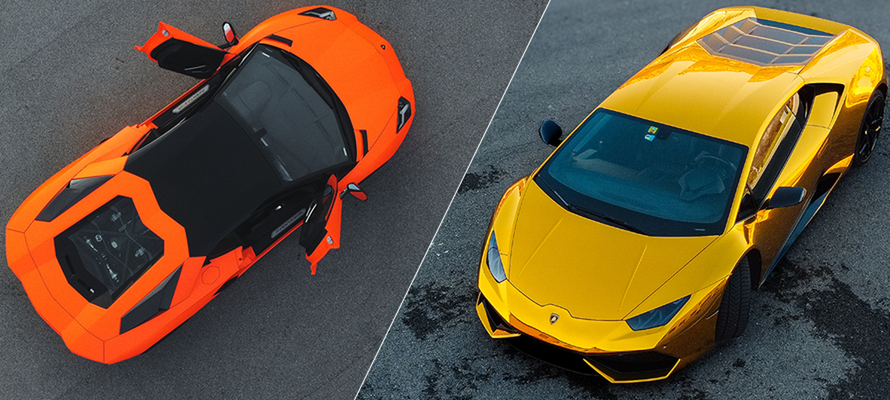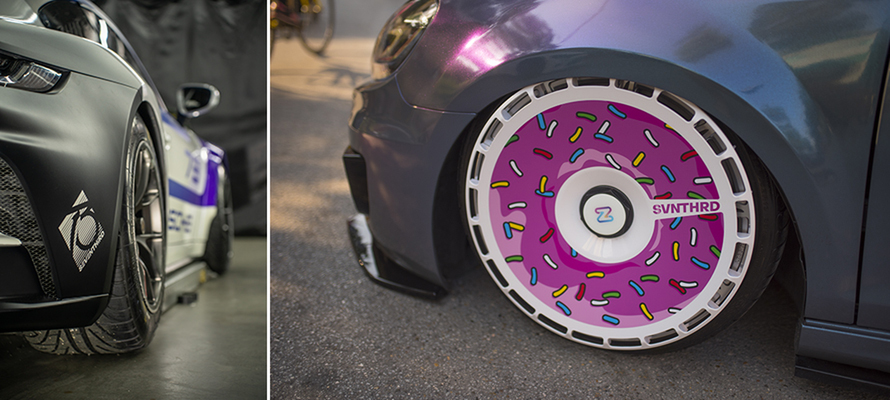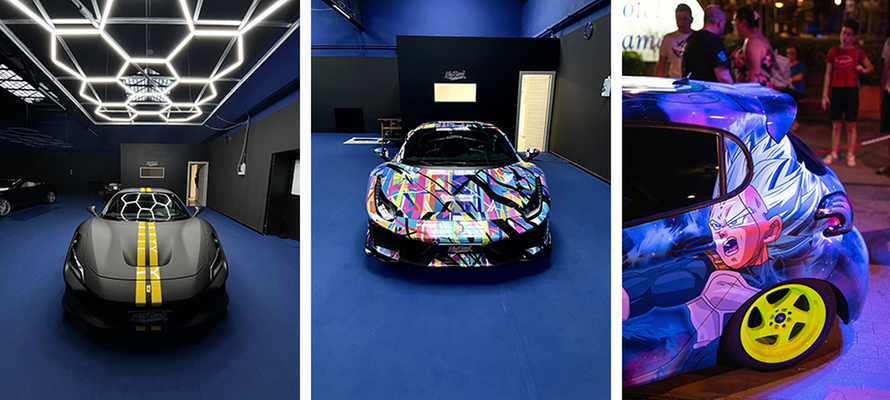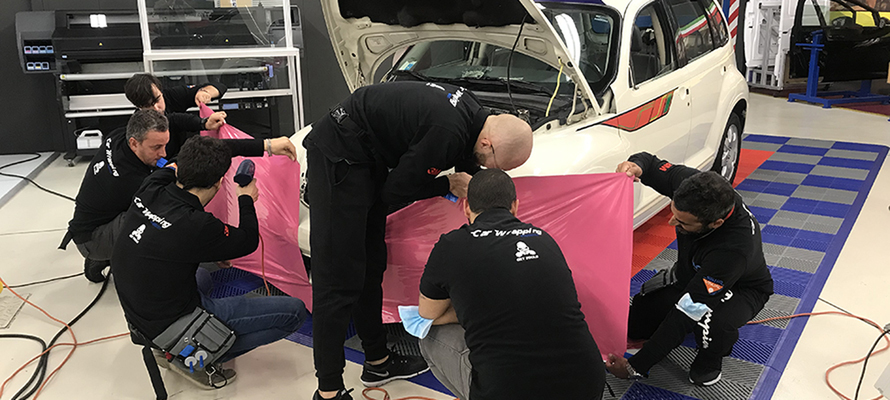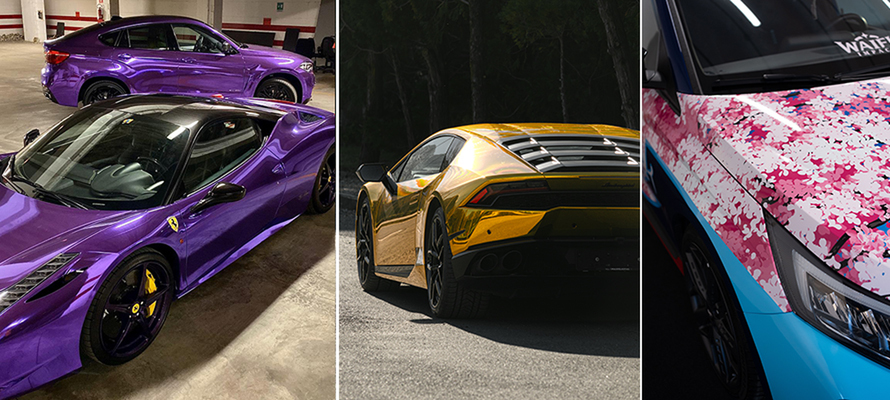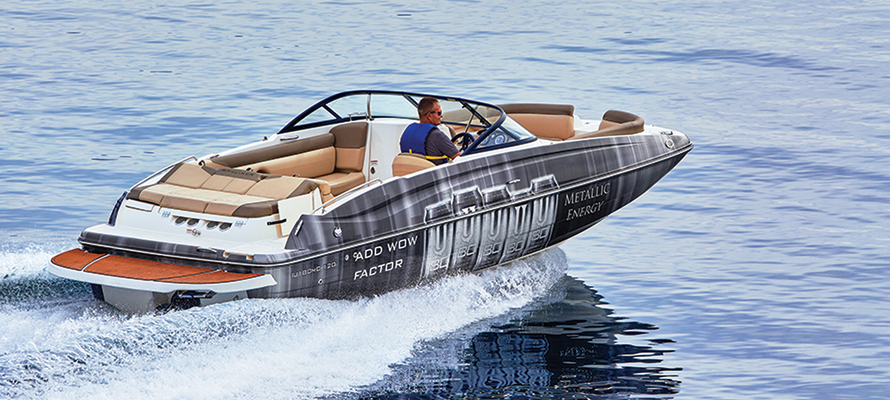All that wrap
Technological innovation now makes it possible to wrap and customise vehicles for aesthetic, protective or promotional reasons. The wrapping market is booming but requires high technical skills and an excellent knowledge of materials.
By Caterina Pucci | On PRINTlovers 102
Although vehicle wrapping has existed since the beginning of the 20th century, until a few decades ago, the existing technologies could only partially wrap a vehicle. Intensive research work aimed at improving the elasticity, adhesion, resistance and printability of adhesives, as well as the management of drawbacks such as the formation of air bubbles, made it possible to develop increasingly high-performance vinyl materials. When the first large-format solvent printers came onto the market in the early 2000s, printed graphics for cars began to gain in popularity. Today, wrapping is a strongly growing segment. In 2021, the market value passed $4.7 billion and is expected to grow further (+22%) by 2030. But what are the characteristics that make wrapping functional? And what technical skills are required to approach this type of application? We asked some professionals in the sector: Nicolas Teverini (Seventhird), Alessandro Barbieri (SIR Visual), Sara Brisinello (Hexis Italia) and Pasquale Esposito (Evosound).
Why does car wrapping pay off?
Car wrapping involves the total or partial application of adhesive films to a vehicle's outer surface. The basis of self-adhesive films is polyvinyl chloride, i.e., PVC, to which plasticising substances are added to make it flexible, pigments to obtain the desired colour shades, and additives to increase resistance, stabilise temperature, or improve printability. Graphics can range from simple logos to structured lettering and creative graphics.
Compared to other customisation techniques, this type of coating offers several advantages. Firstly, it allows you to temporarily change the appearance of the vehicle without having to paint or apply permanent stickers that would damage the bodywork. In addition to aesthetic functionality, the films also offer additional protection from scratches, weathering, or chemicals.
Printing techniques
Printing techniques for wrapping are constantly evolving and vary depending on the project. The most common include vinyl cutting to create pre-spaces or wrap parts to be placed on the vehicle and digital printing on cast film, such as Latex for more flexibility or UV for more vivid colours, used in full wraps or decals. These techniques form the basis of wrapping. In addition, techniques for special effects can be employed, such as the use of resin to give three-dimensionality, chrome finishings, prints on coloured films to create shades or patterns, printing or engraving on ppf or holographic films, prints on photoluminescent or light-sensitive films with spot white to illuminate only certain parts of the wrap, and many others. Recent experiments in the tuning world even include backlighting by applying LEDs under the film.
The wrap designer profession
Only some graphic designers can produce a high-level car wrapping project, as this requires specific skills. In addition to a detailed knowledge of the various types of vinyl films and their properties, knowledge of the processes involved in preparing the vehicle surface, the tools used for application and finishing techniques are essential for achieving quality and long-lasting results. But it doesn't end there. "Unlike a graphic designer, the wrap designer should have a working knowledge of vehicles and their three-dimensional surfaces and should be able to assess the specific challenges associated with designing for vehicles, such as curves, angles and irregular surfaces, to adapt designs accordingly," explains Nicolas Teverini, founder and designer at Seventhird, a design agency specialising in automotive customisation. "In addition, a wrap designer should be able to create designs that are not only aesthetically appealing but also functional in the usage environment, taking into account factors such as visibility, legibility and durability of the wrap over time." Some wraps only require vinyl carving, others combine carving and printing, and still others, fully printed, require detailed graphic work. The design process is usually done in cooperation with the wrapper, as each has their working methods. It also includes details such as margins for cutting or dividing into sections to maximise material utilisation.
To each car its own style
The design of a wrap for a racing car follows a different logic than for a rally car or show car. The requirements can vary even within the same type of project, often influenced by the available budget. For a rally car, you might opt for a cheap and easily restored livery, considering the high exposure to damage during races and the presence of numerous sponsors. You are usually more daring for track cars, especially if they are luxury vehicles, using more valuable materials or more complex techniques, still considering possible collisions on the track. For company vehicles, the emphasis is on brand identity, and the possibility of adapting the livery to different types of vehicles is also considered. The same applies to racing teams with a varied fleet of cars, which require a uniform livery to be created; this can also be seen in gaming. The craft is generally more refined and complex for show cars to ensure perfect exposure and admiration in every detail, sometimes even on the rims. "There are an infinite number of variations depending on the budget and the type of vehicle. For example, wrapping a white car will require more work than a black one, as white is noticeable with any overlapping colour. Therefore, the car must be completely taken apart to get to the bottom of the film. In contrast, black can be treated more flexibly without complete disassembly as it creates a natural shadow," adds Teverini. Ultimately, each project is unique and is assessed individually considering several factors, including customising interior door sills or interior details (sometimes that is all that is required).
As for decoration styles, in Seventhird's experience, much depends on the customer's car culture or niche. For example, in the tuning world, there are categories such as 'German Style', which is clean and refined, keeping the car's lines unaltered and using more elegant colours. In contrast, 'Spanish Style' tends to exaggerate both in colour and design. The influences of JDM (Japanese Domestic Market, an acronym used to refer to the sports cars of the Rising Sun) take their cue from Japanese 'Itasha' (giant pictures of manga characters on the vehicle) or the myth of clandestine racing. American cars often feature classic muscle car stripes, military-style stars and camouflage, or designs from Kustom Kulture. Demands can also be influenced by trends set by influencers or public figures in the industry, as well as by the racing world. In addition, the trend often depends on the age of the vehicle: if it is vintage, the wrap style will generally be old-fashioned or with more classic shapes, whereas, for a modern car, the line of the vehicle itself is more likely to be followed. However, combinations and fusions of styles can create unique and singular designs.
Learning the secrets of the trade
Of course, wrappers do not improvise. To approach the car wrapping business, you should know the characteristics of the various materials, the application techniques and the use of the appropriate accessories. Particular attention must be paid to the surface preparation phase, which is crucial for a successful installation. The need to train specialised professionals has led to the creation of schools such as Wrap&Decor, founded in Brescia in 2012 by SIR Visual in collaboration with 3M Italia.
"Thanks to the professionalism and great experience of an authorised 3M Graphic Market teacher, who follows each participant step by step, the indispensable tricks are illustrated and tested, paying the necessary attention to the management of overlaps, the wrapping of edges and corners of complex shapes, and finishing touches," explains Alessandro Barbieri, Purchasing & Product Manager of SIR Visual. Boat wrapping deserves a separate mention - it allows maximum customisation of the boat's interior and exterior spaces, thanks to the work of specialised applicators and specific adhesive films suitable for covering the boat's hull. "Boat wrapping can be used both during the design phase, when a new livery is needed, and during maintenance, as an alternative solution to painting the hull," Barbieri continues. "The materials are the same as for car wrapping but with specific performances to ensure high resistance to sunlight, wind and seawater. The application technique is also different from car wrapping because the conditions of use and the mechanical stresses to which a boat is subjected are considerable, and it is also necessary to know the correct application techniques to guarantee the durability and hold of the substrates." For this reason, the Wrap&Decor school has introduced a specific course for boat wrapping in which the handling of the most complicated parts of a boat, such as the bow, stern and hull, is analysed, with a focus on the application of the film and its sealing.
The importance of the right film
The main requirements placed on films today are strength, versatility, ease of application and the ability to quickly rectify small mistakes during coating. Therefore, the materials should be developed to remain in optimal condition even if they need to be repositioned after the first application. "Today, the customer is looking for films with ever-higher performance. From an aesthetic point of view, demand focuses on special colours (superchromes, iridescent, glittered, fluorescent), which 'make a noise', succeeding in making the design of a luxury car even more impactful,” explains Sara Brisinello, Brand Manager of Hexis, the Italian branch of the French company specialising in the production of high-end PVC, PU and Latex cast films. “All our films are developed so that the repositioning of the film takes place without damage to the material,” Brisinello continues.
Another requirement relates to keeping the car's original paintwork intact through substrates that can perform a protective function. "These are very specific films, the application of which should not be taken for granted because a lack of knowledge of application techniques risks defeating the purpose for which the customer asked for this film." Among the flagship products developed by Hexis is Bodyfence, a protective film between 150 and 180 microns thick, capable of regenerating itself through heat and hot water. In addition to making the bodywork shinier, this particular substrate can remove damage caused by scratches and bumps and, thanks to its water-repellent properties, protect the car from dirt build-up. Customer support plays a vital role in the research and development work, as it allows the joint evaluation of the best option considering each customer's specific needs. "We also offer basic and advanced level training courses," adds Brisinello, "to learn all the secrets of application for purely aesthetic or protective purposes. The courses accommodate a maximum of four people precisely to ensure that each participant can combine theoretical training with an opportunity to practise under the guidance of a certified instructor. In the case of protective films, which also require specific skills in terms of cutting (different from aesthetic wrapping), it is possible to order pre-cut kits or purchase our software, which enables pre-cutting." On the sustainability front, the company is pursuing a campaign to recover and recycle PVC and liner materials. The Recycling Programme also includes recycling the caps used to keep the reels suspended inside the packaging cartons. These ensure that the reels do not come into direct contact with surfaces that could damage them. Recovered PVC can be reduced to granules and used to produce pipes, while paper liners are used to produce insulation materials.
Tailor-made cuts
Halfway between highly specialised technicians and artists, car-wrappers are increasingly sought after and acclaimed by enthusiasts, their work comparable to real works of art, their skills the subject of heated competitions, such as the World Wrap Master, organised annually by FESPA. Pasquale Esposito, owner of Evosound, tells us about it. Dubbed by many as the 'stylist' of cars, Esposito counts among his clients various personalities from the world of entertainment, from Balotelli to Sfera Ebbasta. "The fundamental thing is to understand what needs are driving the customer to renew the look of their car. Are they professional, promotional, or purely aesthetic motivations? The choice of colours is based on the customer's taste, but above all, on the car's design. Gloss, matt, semi-gloss, glitter, carbon, velvet and 'jungle' (with embossed structures) paints can be further customised by printing, solvent or latex. The wrapping should follow the line, and it is important to apply it meticulously to ensure that the left and right sides match, just like when making a tailor-made suit," concludes Esposito.
By Caterina Pucci | On PRINTlovers 102
Although vehicle wrapping has existed since the beginning of the 20th century, until a few decades ago, the existing technologies could only partially wrap a vehicle. Intensive research work aimed at improving the elasticity, adhesion, resistance and printability of adhesives, as well as the management of drawbacks such as the formation of air bubbles, made it possible to develop increasingly high-performance vinyl materials. When the first large-format solvent printers came onto the market in the early 2000s, printed graphics for cars began to gain in popularity. Today, wrapping is a strongly growing segment. In 2021, the market value passed $4.7 billion and is expected to grow further (+22%) by 2030. But what are the characteristics that make wrapping functional? And what technical skills are required to approach this type of application? We asked some professionals in the sector: Nicolas Teverini (Seventhird), Alessandro Barbieri (SIR Visual), Sara Brisinello (Hexis Italia) and Pasquale Esposito (Evosound).
Why does car wrapping pay off?
Car wrapping involves the total or partial application of adhesive films to a vehicle's outer surface. The basis of self-adhesive films is polyvinyl chloride, i.e., PVC, to which plasticising substances are added to make it flexible, pigments to obtain the desired colour shades, and additives to increase resistance, stabilise temperature, or improve printability. Graphics can range from simple logos to structured lettering and creative graphics.
Compared to other customisation techniques, this type of coating offers several advantages. Firstly, it allows you to temporarily change the appearance of the vehicle without having to paint or apply permanent stickers that would damage the bodywork. In addition to aesthetic functionality, the films also offer additional protection from scratches, weathering, or chemicals.
Printing techniques
Printing techniques for wrapping are constantly evolving and vary depending on the project. The most common include vinyl cutting to create pre-spaces or wrap parts to be placed on the vehicle and digital printing on cast film, such as Latex for more flexibility or UV for more vivid colours, used in full wraps or decals. These techniques form the basis of wrapping. In addition, techniques for special effects can be employed, such as the use of resin to give three-dimensionality, chrome finishings, prints on coloured films to create shades or patterns, printing or engraving on ppf or holographic films, prints on photoluminescent or light-sensitive films with spot white to illuminate only certain parts of the wrap, and many others. Recent experiments in the tuning world even include backlighting by applying LEDs under the film.
The wrap designer profession
Only some graphic designers can produce a high-level car wrapping project, as this requires specific skills. In addition to a detailed knowledge of the various types of vinyl films and their properties, knowledge of the processes involved in preparing the vehicle surface, the tools used for application and finishing techniques are essential for achieving quality and long-lasting results. But it doesn't end there. "Unlike a graphic designer, the wrap designer should have a working knowledge of vehicles and their three-dimensional surfaces and should be able to assess the specific challenges associated with designing for vehicles, such as curves, angles and irregular surfaces, to adapt designs accordingly," explains Nicolas Teverini, founder and designer at Seventhird, a design agency specialising in automotive customisation. "In addition, a wrap designer should be able to create designs that are not only aesthetically appealing but also functional in the usage environment, taking into account factors such as visibility, legibility and durability of the wrap over time." Some wraps only require vinyl carving, others combine carving and printing, and still others, fully printed, require detailed graphic work. The design process is usually done in cooperation with the wrapper, as each has their working methods. It also includes details such as margins for cutting or dividing into sections to maximise material utilisation.
To each car its own style
The design of a wrap for a racing car follows a different logic than for a rally car or show car. The requirements can vary even within the same type of project, often influenced by the available budget. For a rally car, you might opt for a cheap and easily restored livery, considering the high exposure to damage during races and the presence of numerous sponsors. You are usually more daring for track cars, especially if they are luxury vehicles, using more valuable materials or more complex techniques, still considering possible collisions on the track. For company vehicles, the emphasis is on brand identity, and the possibility of adapting the livery to different types of vehicles is also considered. The same applies to racing teams with a varied fleet of cars, which require a uniform livery to be created; this can also be seen in gaming. The craft is generally more refined and complex for show cars to ensure perfect exposure and admiration in every detail, sometimes even on the rims. "There are an infinite number of variations depending on the budget and the type of vehicle. For example, wrapping a white car will require more work than a black one, as white is noticeable with any overlapping colour. Therefore, the car must be completely taken apart to get to the bottom of the film. In contrast, black can be treated more flexibly without complete disassembly as it creates a natural shadow," adds Teverini. Ultimately, each project is unique and is assessed individually considering several factors, including customising interior door sills or interior details (sometimes that is all that is required).
As for decoration styles, in Seventhird's experience, much depends on the customer's car culture or niche. For example, in the tuning world, there are categories such as 'German Style', which is clean and refined, keeping the car's lines unaltered and using more elegant colours. In contrast, 'Spanish Style' tends to exaggerate both in colour and design. The influences of JDM (Japanese Domestic Market, an acronym used to refer to the sports cars of the Rising Sun) take their cue from Japanese 'Itasha' (giant pictures of manga characters on the vehicle) or the myth of clandestine racing. American cars often feature classic muscle car stripes, military-style stars and camouflage, or designs from Kustom Kulture. Demands can also be influenced by trends set by influencers or public figures in the industry, as well as by the racing world. In addition, the trend often depends on the age of the vehicle: if it is vintage, the wrap style will generally be old-fashioned or with more classic shapes, whereas, for a modern car, the line of the vehicle itself is more likely to be followed. However, combinations and fusions of styles can create unique and singular designs.
Learning the secrets of the trade
Of course, wrappers do not improvise. To approach the car wrapping business, you should know the characteristics of the various materials, the application techniques and the use of the appropriate accessories. Particular attention must be paid to the surface preparation phase, which is crucial for a successful installation. The need to train specialised professionals has led to the creation of schools such as Wrap&Decor, founded in Brescia in 2012 by SIR Visual in collaboration with 3M Italia.
"Thanks to the professionalism and great experience of an authorised 3M Graphic Market teacher, who follows each participant step by step, the indispensable tricks are illustrated and tested, paying the necessary attention to the management of overlaps, the wrapping of edges and corners of complex shapes, and finishing touches," explains Alessandro Barbieri, Purchasing & Product Manager of SIR Visual. Boat wrapping deserves a separate mention - it allows maximum customisation of the boat's interior and exterior spaces, thanks to the work of specialised applicators and specific adhesive films suitable for covering the boat's hull. "Boat wrapping can be used both during the design phase, when a new livery is needed, and during maintenance, as an alternative solution to painting the hull," Barbieri continues. "The materials are the same as for car wrapping but with specific performances to ensure high resistance to sunlight, wind and seawater. The application technique is also different from car wrapping because the conditions of use and the mechanical stresses to which a boat is subjected are considerable, and it is also necessary to know the correct application techniques to guarantee the durability and hold of the substrates." For this reason, the Wrap&Decor school has introduced a specific course for boat wrapping in which the handling of the most complicated parts of a boat, such as the bow, stern and hull, is analysed, with a focus on the application of the film and its sealing.
The importance of the right film
The main requirements placed on films today are strength, versatility, ease of application and the ability to quickly rectify small mistakes during coating. Therefore, the materials should be developed to remain in optimal condition even if they need to be repositioned after the first application. "Today, the customer is looking for films with ever-higher performance. From an aesthetic point of view, demand focuses on special colours (superchromes, iridescent, glittered, fluorescent), which 'make a noise', succeeding in making the design of a luxury car even more impactful,” explains Sara Brisinello, Brand Manager of Hexis, the Italian branch of the French company specialising in the production of high-end PVC, PU and Latex cast films. “All our films are developed so that the repositioning of the film takes place without damage to the material,” Brisinello continues.
Another requirement relates to keeping the car's original paintwork intact through substrates that can perform a protective function. "These are very specific films, the application of which should not be taken for granted because a lack of knowledge of application techniques risks defeating the purpose for which the customer asked for this film." Among the flagship products developed by Hexis is Bodyfence, a protective film between 150 and 180 microns thick, capable of regenerating itself through heat and hot water. In addition to making the bodywork shinier, this particular substrate can remove damage caused by scratches and bumps and, thanks to its water-repellent properties, protect the car from dirt build-up. Customer support plays a vital role in the research and development work, as it allows the joint evaluation of the best option considering each customer's specific needs. "We also offer basic and advanced level training courses," adds Brisinello, "to learn all the secrets of application for purely aesthetic or protective purposes. The courses accommodate a maximum of four people precisely to ensure that each participant can combine theoretical training with an opportunity to practise under the guidance of a certified instructor. In the case of protective films, which also require specific skills in terms of cutting (different from aesthetic wrapping), it is possible to order pre-cut kits or purchase our software, which enables pre-cutting." On the sustainability front, the company is pursuing a campaign to recover and recycle PVC and liner materials. The Recycling Programme also includes recycling the caps used to keep the reels suspended inside the packaging cartons. These ensure that the reels do not come into direct contact with surfaces that could damage them. Recovered PVC can be reduced to granules and used to produce pipes, while paper liners are used to produce insulation materials.
Tailor-made cuts
Halfway between highly specialised technicians and artists, car-wrappers are increasingly sought after and acclaimed by enthusiasts, their work comparable to real works of art, their skills the subject of heated competitions, such as the World Wrap Master, organised annually by FESPA. Pasquale Esposito, owner of Evosound, tells us about it. Dubbed by many as the 'stylist' of cars, Esposito counts among his clients various personalities from the world of entertainment, from Balotelli to Sfera Ebbasta. "The fundamental thing is to understand what needs are driving the customer to renew the look of their car. Are they professional, promotional, or purely aesthetic motivations? The choice of colours is based on the customer's taste, but above all, on the car's design. Gloss, matt, semi-gloss, glitter, carbon, velvet and 'jungle' (with embossed structures) paints can be further customised by printing, solvent or latex. The wrapping should follow the line, and it is important to apply it meticulously to ensure that the left and right sides match, just like when making a tailor-made suit," concludes Esposito.
